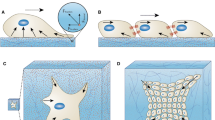Abstract
To make visible the traction forces exerted by individual cells, we have previously developed a method of culturing them on thin distortable sheets of silicone rubber1. We have now used this method to compare the forces exerted by various differentiated cell types and have examined the effects of cellular traction on re-precipitated collagen matrices. We find that the strength of cellular traction differs greatly between cell types and this traction is paradoxically weakest in the most mobile and invasive cells (leukocytes and nerve growth cones). Untransformed fibroblasts exert forces very much larger than those actually needed for locomotion. This strong traction distorts collagen gels dramatically, creating patterns similar to tendons and organ capsules. We propose that this morphogenetic rearrangement of extracellular matrices is the primary function of fibroblast traction and explains its excessive strength.
Similar content being viewed by others
References
Harris, A. K., Wild, P. & Stopak, D. Science 208, 177–179 (1980).
Elsdale, T. & Bard, J. J. Cell Biol. 54, 626–637 (1972).
Bell, E., Ivarsson, B. & Merril, C. Proc. natn. Acad. Sci. U.S.A. 76, 1274–1278 (1979).
Stuart, E. S. & Moscona, A. A. Science 157, 947–948 (1967).
Wessels, N. K. & Evans, J. Devl Biol. 18, 42–61 (1968).
Weiss, P. A. in Biological Organisation (ed. Waddington, C. H.) 12–13 (Pergamon, New York, 1959).
Trelstad, R. L. & Hayashi, K. Devl Biol. 71, 228–242 (1979).
Weiss, P. A. in Analysis of Development (eds Willier, B. H., Weiss, P. A. & Hamburger, V.) 346–401 (Saunders, Philadelphia, 1955).
Peacock, E. E. & Van Winkle, W. Wound Repair Ch. 3 (Saunders, Philadelphia, 1976).
Abercrombie, M., Flint, M. H. & James, D. W. J. Embryol. exp. Morph. 4, 167–174 (1954).
Gayou, R. & Rudolph, R. Ann. Plastic Surg. 2, 62–71 (1979).
Author information
Authors and Affiliations
Rights and permissions
About this article
Cite this article
Harris, A., Stopak, D. & Wild, P. Fibroblast traction as a mechanism for collagen morphogenesis. Nature 290, 249–251 (1981). https://doi.org/10.1038/290249a0
Received:
Accepted:
Issue Date:
DOI: https://doi.org/10.1038/290249a0
- Springer Nature Limited
This article is cited by
-
Wrinkle force microscopy: a machine learning based approach to predict cell mechanics from images
Communications Biology (2022)
-
Stress fibres and the cortex work in tandem
Nature Materials (2021)
-
Mechanical Models of Pattern and Form in Biological Tissues: The Role of Stress–Strain Constitutive Equations
Bulletin of Mathematical Biology (2021)
-
Role of IL-24 in the mucosal remodeling of children with coeliac disease
Journal of Translational Medicine (2020)
-
Targeting Cell Contractile Forces: A Novel Minimally Invasive Treatment Strategy for Fibrosis
Annals of Biomedical Engineering (2020)





